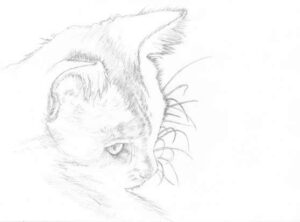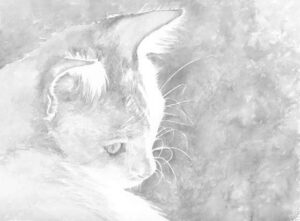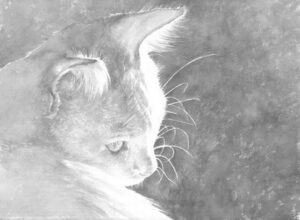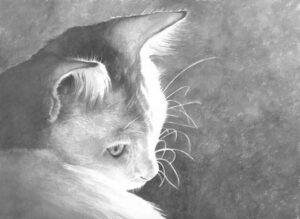
In an article in the September 2014 issue of Paint, I wrote about finding new inspiration from my collection of old books and the gorgeous black and white illustrations adorning such classics as ‘The Jungle Book’ and ‘Alice’s Adventures in Wonderland’. The response to my new ink paintings and ink pen sketches which have been inspired by these books has been amazing, so I would like to share with you some of the techniques that I have learned. Indian ink is traditionally made from one of the oldest pigments, carbon black or lampblack. It is made with fine soot and a shellac binder typically, which when dry creates a permanent, lightfast artwork. It can be used for many different styles of artwork, including line and wash and graphic comic book illustration, using nib pens or brushes and lends itself perfectly to creating images with darker tones as in the painting of my black cat Marley, which was my first complete Indian ink painting, followed by a painting of a black leopard, inspired by Rudyard Kipling’s Jungle Books.
Although the obvious choice of animal subject for Indian ink would be those with darker fur, the soft grey tones that can be achieved with diluted ink offer much more versatility than you might at first think. So for this step-by-step demonstration, I will show you how the subtlety of Indian ink can be used to create an interesting and atmospheric painting using one of my white cats, Phoebe, as the subject. I will be using just one brush, the No.4 SAA Large Detailer brush, the long hairs of which can be used for broader strokes as well as more detailed work.
1 I started out by sketching Phoebe on the watercolour paper with a 2B graphite pencil. Any extraneous lines can be removed with a kneadable eraser prior to commencing the inking process, or even after the first light ink wash. I included as much detail as I needed in the finished painting, even the whiskers. I like to draw in the whiskers and paint around the outlines but, if you prefer, you can use masking fluid and an SAA masking fluid brush to mask out the whiskers and protect other delicate hairs. Diluting the masking fluid with 50% water helps to create much finer lines. I also included some basic shading with the pencil to indicate where the shadows would be in the finished painting.
I started out by sketching Phoebe on the watercolour paper with a 2B graphite pencil. Any extraneous lines can be removed with a kneadable eraser prior to commencing the inking process, or even after the first light ink wash. I included as much detail as I needed in the finished painting, even the whiskers. I like to draw in the whiskers and paint around the outlines but, if you prefer, you can use masking fluid and an SAA masking fluid brush to mask out the whiskers and protect other delicate hairs. Diluting the masking fluid with 50% water helps to create much finer lines. I also included some basic shading with the pencil to indicate where the shadows would be in the finished painting.
2 I then proceeded with the first wash of very dilute ink to create the lightest grey tones in the painting, using the side of the brush – leaving the highlights, including the whiskers, as bare paper. I find that painting around and between the whiskers with the fine point on the brush is very relaxing, almost therapeutic. It is recommended that you dilute Indian ink with distilled or de-ionised water, as the fluoride in tap water can split the shellac binder and cause streaking. As the ink, even when diluted, dries very quickly, it is better to paint small areas at a time to be able to soften the edges with a damp brush; not so important in the background, as naturally occurring texture can have a pleasing visual effect, especially when contrasted with the softer, smoother kitten fur. A second wash, using the same diluted mix creates a slightly darker tone in the background, forehead and around the ears.
I then proceeded with the first wash of very dilute ink to create the lightest grey tones in the painting, using the side of the brush – leaving the highlights, including the whiskers, as bare paper. I find that painting around and between the whiskers with the fine point on the brush is very relaxing, almost therapeutic. It is recommended that you dilute Indian ink with distilled or de-ionised water, as the fluoride in tap water can split the shellac binder and cause streaking. As the ink, even when diluted, dries very quickly, it is better to paint small areas at a time to be able to soften the edges with a damp brush; not so important in the background, as naturally occurring texture can have a pleasing visual effect, especially when contrasted with the softer, smoother kitten fur. A second wash, using the same diluted mix creates a slightly darker tone in the background, forehead and around the ears.
3 Working from light to dark, using progressively less diluted ink, I began to increase the tonal values safe in the knowledge that the first layer is permanent and will not be lifted out as with watercolour. This is a very useful quality of Indian ink, as the textures that you create, whether it be vague background textures, foliage or fur, remain visible through the wash layers. At this stage I began painting the fur strokes, which are created by the shadows of overlapping white hairs, and gradually increasing the darker tonal elements, such as the eye rim and edges of the ears. Increasingly darker tones and more subtle textures were added in the background, which will eventually enhance the highlights and whiskers.
Working from light to dark, using progressively less diluted ink, I began to increase the tonal values safe in the knowledge that the first layer is permanent and will not be lifted out as with watercolour. This is a very useful quality of Indian ink, as the textures that you create, whether it be vague background textures, foliage or fur, remain visible through the wash layers. At this stage I began painting the fur strokes, which are created by the shadows of overlapping white hairs, and gradually increasing the darker tonal elements, such as the eye rim and edges of the ears. Increasingly darker tones and more subtle textures were added in the background, which will eventually enhance the highlights and whiskers.
4 I used slightly darker washes of ink to create stronger shadows in the forehead, behind the ears and neck, which increase the lighter values, such as the light shining through Phoebe’s ears. Darker tones in the background around the whiskers strengthen their shape and really make them shine. I used the strongest mix of ink and distilled water to paint in the final details, the eye rim, pupil, nostril and inner ear. If you use masking fluid, remove this gently with a clean finger or maskaway block– any slightly rough edges left behind from the masking fluid can easily be touched up with the point of your brush. I hope you have enjoyed this demonstration. After years of painting animals in pastels, I am happy to have discovered another medium which excites me. There will be many more Indian ink paintings on my easel, I’m sure; and you can find more on this medium in my book, ‘Painting and Drawing Cats’.
I used slightly darker washes of ink to create stronger shadows in the forehead, behind the ears and neck, which increase the lighter values, such as the light shining through Phoebe’s ears. Darker tones in the background around the whiskers strengthen their shape and really make them shine. I used the strongest mix of ink and distilled water to paint in the final details, the eye rim, pupil, nostril and inner ear. If you use masking fluid, remove this gently with a clean finger or maskaway block– any slightly rough edges left behind from the masking fluid can easily be touched up with the point of your brush. I hope you have enjoyed this demonstration. After years of painting animals in pastels, I am happy to have discovered another medium which excites me. There will be many more Indian ink paintings on my easel, I’m sure; and you can find more on this medium in my book, ‘Painting and Drawing Cats’.
Notifications